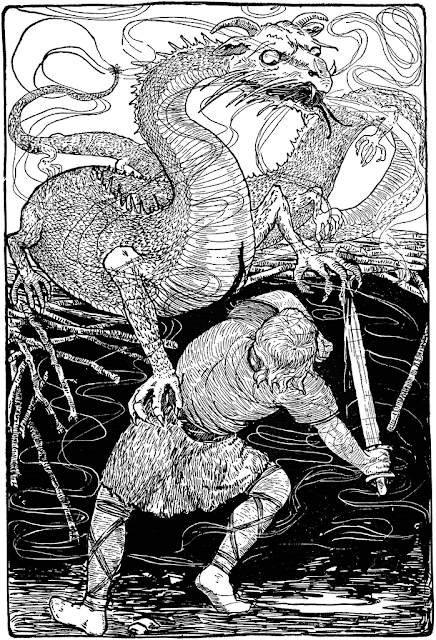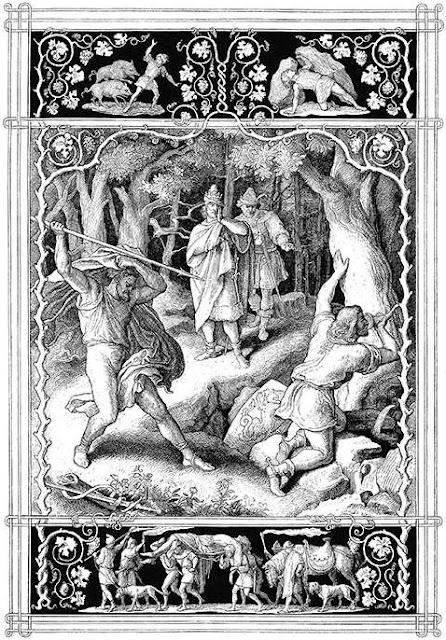Mythology matters. The tales we tell reflect our values, even when we tell ourselves that they do not. The old stories bring with them the old worldviews, yet we are not duty-bound to accept everything that is woven into the texts to which we still return after all these long centuries.
In the formulation of French philosopher Paul Ricœur, myths are spaces where symbols interact in narrative form. Symbols are notoriously slippery, and what they may have meant to the peoples of the long ago time are not necessarily the same meanings they carry to all of us in the now.
One of the stories that now seems particularly pregnant with contemporary meaning is that of the Sigurd and the dragon.
 |
| Sigurd and the dragon in Tales from the Far North (1909) by Maria C. Klugh |
The Old Norse poem Reginsmál (“Sayings of Regin [the mighty one]”) tells the tale of the famously cursed treasure hoard that plays a major role in the tragic events of the Icelandic Völsunga saga (“Saga of the Völsungs”) and the German Nibelungenlied (“Song of the Nibelungs”), both written down in the thirteenth century.
The poem begins in the mythological world of gods, giants, and dwarfs before pivoting halfway through to the legendary world of Sigurd, the Odin-descended dragon slayer distantly connected to the historical sixth-century Frankish king Sigibert.
Regin the smith, who is either a dwarf or simply “a dwarf in height,” tells his mythic backstory to the young Sigurd, sent to him to be raised as a foster-son. Here are the key elements, briefly retold.
The smith’s tale
The gods Odin and Hœnir and the giant Loki arrive together at a waterfall. Loki throws a stone to kill an otter sitting on the riverbank with his eyes closed, eating a salmon. The trio makes a bag from the otter’s skin and proudly show it and the fish to Regin’s father Hreidmar, with whom they spend the night.
The animal killed by Loki was actually Otr (“otter”), another son of Hreidmar, who had the habit of fishing at the waterfall while changed into the form of an otter. The father and his other sons grab Odin, Hœnir, and Loki, then threaten the trio with death unless they fill the otter-skin bag with gold and cover it with the same.
The two gods send Loki to find the needful gold. He borrows the net of the sea-goddess (or sea-giantess) Rán (“robbery”), returns to the waterfall, and catches the dwarf Andvari (“careful”) who had been cursed by a norn “in the early days” to swim in the water as a pike.
Echoing the deadly threat of Hreidmar, Loki demands that the dwarf-turned-fish hand over all his gold, including the ring Andvaranaut (“Andvari’s gift”). As he retreats into a rock, Andvari curses the gold and declares that it will cause death and strife.
When Loki returns to Hreidmar with the treasure, the gold is used to fill the otter-skin bag and cover it up. One whisker pokes out, and Odin gives up the dwarf’s ring to cover it at their host’s demand.
Loki passes along the curse, which immediately claims Hreidmar as its first victim. Regin and Fáfnir (“embracer”) demand “a share of the compensation from Hreidmar for their brother.” When their father refuses, Fáfnir kills him in his sleep, takes all of the treasure, and guards it in the form of a dragon wearing an ægishjálmr (“helmet of terror”) that causes abject fear in all living beings.
Sacred heart
The sequel to the smith’s story appears in the poem Fáfnismál (“Sayings of Fáfnir”), in which Sigurd is led by Regin to find and kill the dragon. The youth fatally stabs Fáfnir in the heart, but the two manage to have a lengthy conversation before the monster expires.
Fáfnir passes the curse on to Sigurd, who seems completely unconcerned. The dying dragon brags of his days of terroristic rule:
The helm of terror I wore among the sons of men,
while I lay upon the neck-rings [i.e. atop the treasure hoard];
more powerful than all I thought myself to be,
I didn’t encounter many equals.
With a final imprecation that Sigurd will die at the hand of his brother Regin, the dragon expires. The smith cuts out his heart, drinks the dragon’s blood, and instructs Sigurd to roast the heart for him while he takes a nap.
Roasting the heart on a spit, Sigurd pokes it to test how done it is, burns his finger, and sticks his finger in his mouth. By tasting the little bit of Fáfnir’s hjartablóð (“heart blood”), he is immediately able to understand the speech of birds. They warn him that Regin plans to kill him, tell him to take the treasure for himself, and send him off to waken the Valkyrie Sigrdrífa (“victory driver”).
The poem Sigrdrífumál (“Sayings of Sigrdrífa”) tells of Odin sticking the Valkyrie with a svefnþorni (“sleep thorn”), declaring that she will never win again in battle, and announcing that she will be married. In other words, he casts her out of the world of the gods and withdraws her Valkyrie status.
Even yet, she retains much wisdom regarding the magical use of runes and Odinnic aphorisms for right living. She shares all of this lore in great detail with Sigurd (and us) after he asks her to teach him wisdom and “news from all the worlds.”
At this point, the thirteenth-century manuscript source of the poems has a notorious lacuna where several leaves were cut out of the codex. When the story resumes in the next poem fragment, Sigurd has become fatally embroiled in the very human world of kinship entanglements and is killed “on the south side of the Rhine” by one of his brothers-in-law.
A stone’s throw away
How can we read this hoary old tale so that it has meaningful resonance in today’s world? One way of beginning is to follow Ricœur and consider the symbols that interact in the narrative.
When Odin wanders the road with Loki as one of his companions, it is the giant who has sworn blood-brotherhood with him whose seemingly inconsequential action – throwing a rock at a sleeping otter – does indeed have deep consequences. From the beginning of the story, the danger comes from within the family.
When the trio arrives at Hreidmar’s, they come into conflict with another trio and another family: the father and his two sons, all suffering the loss of the third brother as the wanton pruning of a healthy branch on their tree of kinship.
After the wounded trio threaten death unless they are given gold, Loki passes on the same threat to the dwarf, minding his own business under the waterfall just as the otter had done beside it before being killed by Loki. In this tightly constructed narrative, everything is echoed and reflected back on itself.
Indeed, just as the dwarf had been cursed by the unnamed norn, he himself curses Loki for taking his amassed hoard of gold. As Andvari attempted to hold back the last ring from Loki, Odin attempts to hold it back from Hreidmar. As Loki was cursed for taking the gold from Andvari, Hreidmar is cursed for taking it from Loki.
This particular section of the myth ends where it began, with the killing of a member of Hreidmar’s family. Loki kills Otr and gets a pelt; Fáfnir kills his father and gets a hoard.
In the twelve verses that (with prose interpolations) make up this section, Loki passes on the curse in the exact middle. Actually, Loki is truly in the middle of this set of concentric circles that spread out like ripples in the pool under the waterfall, as the dwarf-fish turns its tail and utters its curse on the gold.
Loki instigates the action with his apparently casual throw of the stone, yet the results pass through him without affecting him. He acts as conduit and conductor for threats of death and for curses of dark magic, but he seems free enough to walk away at any point with no ill effects.
Yes, Hreidmar’s family is destroyed, but the ultimate target of Loki’s throw won’t become apparent until the next bit of the story.
Ascent and descent
After receiving his death blow from Sigurd, the dragon passes on the curse to the young hero. The long arm of Loki begins to reveal itself, as the curse moves from Hreidmar’s family to that of Odin.
Sigurd is of the Völsung line and is the great-great-great-grandson of Odin the Allfather. He carries the reforged sword originally awarded to his father Sigmund by the god, but the gift of Odin is canceled out by the gift Loki gives – the dwarf’s fatal curse.
 |
| Death of Sigurd/Siegfried in Der Nibelungen Noth (1843) edited by Gustav Pfizer |
Before the curse can take effect, Sigurd tastes the blood of his vanquished enemy and gains something of the dragon’s deeper powers of understanding. Listening to the advice of the birds he can suddenly understand, he sets off to climb the mountain and learn the lore of the mystic woman strong enough to disobey the orders of Odin, face his divine wrath, and live to tell her tale.
Sigrdrífa inverts Loki’s role: where the giant served as a conduit to pass on the dwarf’s curse to Hreidmar – and ultimately to Sigurd and beyond – the Valkyrie serves as a conductor of Odin’s divine wisdom, passing it along to the young hero. Even further distinguished from Loki, she effectively filters the knowledge presented to Sigurd by absorbing the dark denunciations of her that Odin had made without passing them along as Loki did by giving Hreidmar both treasure and curse.
When Sigurd makes his Zarathustrian descent from the mountain, he leaves the world of mystic beings and enters the world of humanity. Despite the wisdom gained from the dragon, the birds, and the Valkyrie, he succumbs to the smothering web of jealousy, lust, hatred, and greed. But among these lowest of human drives, the hand of mythology reaches into the more mundane world of heroic legend, and the curse tips the emotional scales towards darkness and death.
Loki’s simple toss of a stone has resulted in the death of the greatest of Odin’s human descendant, and – according to the Old Norse material – the greatest hero of the northern world. Although some today still tie Loki to the tradition of the culture hero, here he spectacularly fails to meet the criteria of bringing direct help to humanity and instead seems to revel in passing on the curse to generations “not yet born.”
No decoder ring needed
Parsing the events of the myth in this fashion is a necessary first step, but it only provides one possible interpretation of the symbolic interactions within the world of mythology.
The simple act of choosing and enunciating an interpretation is dangerous enough in itself, as it runs the risk of offending those who hold other and differing interpretations close to their hearts. Taking the next step of forming new and modern meanings leaves one open to denunciations of blasphemy, an ancient concept that – like so much from the past that perhaps should have stayed there – has gained new life in this strange era we are all traveling through together.
There is a great deal in the old tales that resonates today, so there is nothing for it but to jump in with both feet.
The myth is saturated with betrayal from inside the family, from inside the community that has been bound together by oath and deed. We merely have to look around ourselves today to see that those who swear to protect and to serve are instead gunning down the unarmed and beating down the peaceful. Those who take oaths to preserve, protect, and defend our highest laws are instead openly breaking them. Those who claim to be defending their communities are instead eagerly seeking to harm their neighbors. We in the United States of America are a family, and we are hurting each other.
As the prophecies of the Old Norse Völuspá (“Prophecy of the Seeress”) and the Sanskrit Mahābhārata (“Great Epic of the Bhārata Dynasty”) both warn, the important relationships that sustain our societies break down in the darkest times of our history. A cursed hoard is the vehicle for the drive into disaster in the mythic world; in our modern world, we only needed an infinitesimal virus to enter our bodily systems for our social systems to begin crumbling around us.
Whether through manipulation of the curse or through his own flawed character, Fáfnir first commits patricide and then turns into a dragon to guard his ill-gotten wealth and snort poison around himself. The meaning of the dragon transformation becomes clearer when stood next to Regin being “a dwarf in height” when he first meets Sigurd. The overwhelming greed of Fáfnir – what J.R.R. Tolkien called “the dragon-sickness” – has made him into an actual monster, as the intense jealousy of his brother Regin has shrunk him down as it eats at him from the inside.
When the emoluments clause of the U.S. Constitution disappears in a puff of burning smoke before one man’s determined self-dealing, when consuming envy of the undeniably great African-American contributions to our culture leads fully grown adults to cheer on a teenage boy who crossed state lines to kill his fellow citizens, we don’t need a secret decoder ring to explain the symbolism of the mythic figures.
Who will tell the tale?
We have before us the story of a child who is sent off to be fostered in the smithy and develops into the greatest hero of the cultures that told these tales. That in itself should resonate with any who still believe in the fading memory of the so-called American dream. It surely resonates with those among us who face a daily struggle to make a better life for themselves and their families, whether the world is against them or no.
Armed with nothing but his own youthful courage, Sigurd defeats an amoral monster who is willing to kill his own father for money, to do anything to anyone to protect his stolen wealth, and who – in his final moments – wants nothing more than to hold onto to his terroristic power.
To each their own beliefs, but I believe in the young people in the streets right now who are taking incredible personal risks as they stand up to tyranny and terror, as they oppose lawless officers of the law, as they declare that black lives do indeed matter, as they insist that hate has no place here – and I believe that these brave youth are the heroes of our own story.
By tasting the heart-blood of the dragon he has vanquished, Sigurd is able to understand the speech of birds who fly far and know much. Aside from mystical interpretations, it is obvious that overcoming seemingly overwhelming difficulties brings us new insight into the world. We have to earn the wisdom we have, and it is acquired with difficulty as we struggle through our lived lives. The birds can be read as representing the promptings of the spirit to take action in the world, with “spirit” read in whatever way is most meaningful to the reader. There is definitely a need for meaningful action in this world of ours today.
The story of ascending the mountain to awaken the Valkyrie and seek her wisdom can understandably lead to mystical interpretations, but it can also be read as a reflection on the struggle to become enlightened in the “Age of Enlightenment” sense. Whether or not wisdom is hidden behind a ring of fire, it is never easily gained. In our time when even common sense is uncommon, when people take the random rantings of self-absorbed politicos over the considered advice of medical professionals, true wisdom is rarer than gold and worth more than any gem.
Sigurd descends the mountain, however, and is brought down by the failings of the human world. Both the curse and the inherent vices of human society are inexorable, and this too is a hard lesson for us to learn. Whatever our political persuasions, whatever our backgrounds and allegiances, all of us who call ourselves Americans are living under the curse of racism that reaches out from the year 1619 and strangles our nation still today. This curse is as powerful and as transgenerational as any called down by a righteously furious dwarf-fish.
Yet there is hope in myth, as there is in life. Before the curse can take effect and take his breath, Sigurd was able to slay a mighty monster and sit at the feet of divinity. What will we each of us do in the years that we are fated to live? Will we rise up from apprentice to hero, face down the monsters of our time, and welcome the wisdom of wise women? Or will we shrivel up in jealousy and grow monstrous in greed? Our stories are yet unwritten, and we ourselves will tell our own tales.
Quotations from the Old Norse poems are from The Poetic Edda, translated by Carolyne Larrington (Oxford World’s Classics, 2014). An earlier version of this article appeared at The Wild Hunt.








